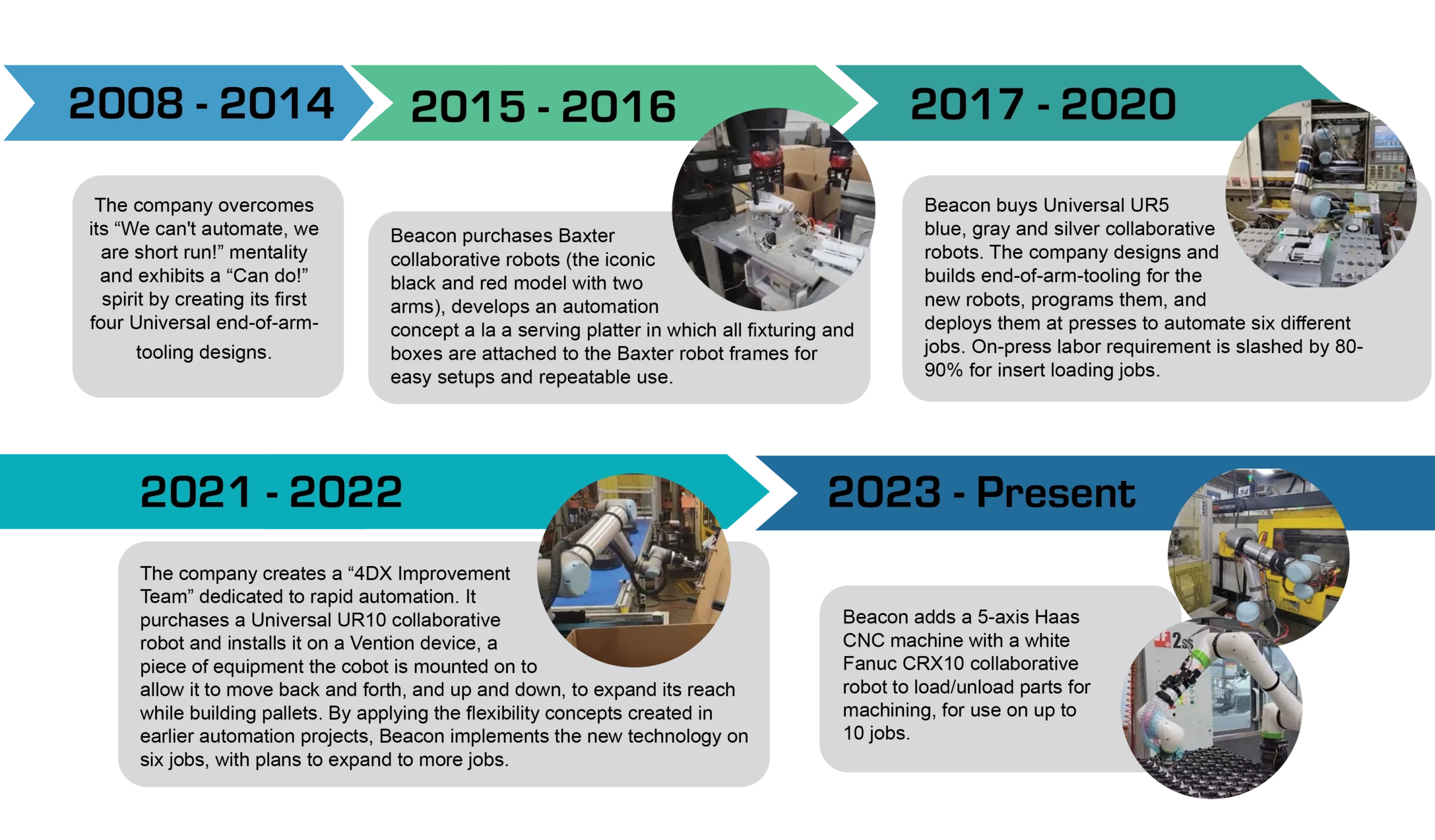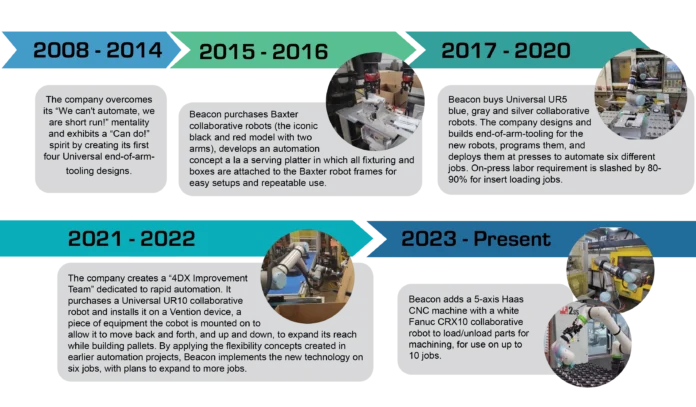By Liz Stevens, writer, Plastics Business
Beacon Engineered Solutions earned the second place award in Labor Solutions at the 2023 MAPP Innovation Award ceremony for its entry describing the company’s 4DX Automation Team which has applied automation technologies that currently save the company 11,000 labor hours annually. Beacon is in Alexandria, Minnesota, offering engineering services, project launch management, ongoing production/inventory management, injection molding and value-add secondary operations. The company handles nearly 2,000 active molds and more than 400 resins in a 24/7 operation.
For this article, Plastics Business talked with Jerry Bienias, general manager, for a close-up look at some of the automation projects implemented at Beacon – the inspiration, the processes and tools used and the lessons learned.
The need for automation at Beacon was easy to see. “Beacon Engineered Solutions has 1,900 active molds, 39 injection molding machines, performs 25-40 setups per day with an average run of 15 hours and has a significant amount of insert and plastics part over-molding work,” Bienias explained. “The first step toward automation, however, was overcoming our ingrained but flawed mentality that ‘we can’t automate, we are short run!’ Reducing labor dependence in our low volume/high mix manufacturing environment was vital for the welfare of the enterprise and for the welfare of our workforce, and so we began considering automation.”
The company found that automation houses could not accommodate Beacon’s need for robot/cobot flexibility, adaptability and ever-expanding use. “Our general experience is that these suppliers create automation to perform a single job or possibly multiple jobs that are very similar,” Bienias said. That business model did not fit with Beacon’s diverse needs. “We reconfigure the work area at the press on most jobs, multiplied by 25-40 setups per day, so we have to be flexible,” Bienias explained. “We decided that we had to build the muscle/skills ourselves to configure and build this variety and volume of automation because we could not afford to pay someone else to do it.”
“Beacon needed automation that was flexible and portable,” Bienias said, “that could be easily configured to perform multiple types of tasks in a number of different work cells. We decided to address the challenge by developing the skills needed internally to design, build, program and implement our automation technologies.”
“Our first go-around into automation was tackling simple part removal automation with gantry style robots on our injection molding presses. While this is generally not that complex of a task, the issue we faced was cost-effectively automating jobs that only run 25-50 hours a year. We solved this roadblock by designing four Universal end-of-arm-tool (EOAT) layouts that we could configure in many different ways to pull parts out of the molds.”
 Beacon determined that, for its automation efforts to generate a good ROI, the company had to automate at least five to 10 different parts with each new type of automation investment. “We move the cobots from press to press which does require some setup for each cobot move, but not as much as it could require because we have tried to standardize the process. Our concept was and is that every piece of automation is mobile and can work on multiple presses to maximize utilization.”
Beacon determined that, for its automation efforts to generate a good ROI, the company had to automate at least five to 10 different parts with each new type of automation investment. “We move the cobots from press to press which does require some setup for each cobot move, but not as much as it could require because we have tried to standardize the process. Our concept was and is that every piece of automation is mobile and can work on multiple presses to maximize utilization.”
Designing effective, efficient automation involves analyzing a manual process and breaking the process down into individual steps that can be performed by a robot. “We have been a short- to medium-run custom injection molder for most of our 40-year existence,” Bienias said. “With the number of presses we have and the high number of setups we do each day, we have standardized many of our processes and equipment to simplify and cut out as much wasted time and motion as possible. We have carried this same standardization approach into our automation processes as well, making sure all of our robots are set up the same way so that we can move them to different work cells and perform varied tasks easily.”
A mix of skills and experience is required to design, program and implement automation. “We were fortunate,” said Bienias, “to have some very talented people in our maintenance, fixture design, manufacturing engineering and tool room groups. These folks had built up a lot of skills over their careers; they were excited to figure out how to apply those skills to designing, building and programming our automation.”
That advanced knowledge and experience was especially helpful for automating some of Beacon’s complicated load-unload procedures. One of the common automation tasks to be conceptualized and designed involved having a cobot reach into the molding machine, extract an over-molded part with one part of its EOAT and then rotate to insert a new part – already held in another part of its EOAT – to be over-molded. “That was something we had to overcome with every job we have launched with machine tending capabilities,” Bienias said. “We did not want the cobot to have to go in and remove something, and then come out of the press, pick something up and go back in – that takes too much time. In each of our designs, the robot has to go in and remove parts and then put another part in for the next cycle.” This can be very challenging since with some molds there is very limited space available for a cobot-EOAT. Some of Beacon’s problem-solving creativity includes having EOAT grippers attached in unusual locations to remove a part from a mold and add a new insert – in one smooth operation.
The company gauged its success with automation projects by tracking the labor hours saved by implementing robotics. At its modest start with cobots in 2015, automation cut 500 annual labor hours (equal to .25 FTE). At the five-year mark in Beacon’s cobot automation journey, projects totaling 1,800 saved annual labor hours were implemented, for a cumulative 8,700 labor hours saved since the 2015 start. When the company’s dedicated 4DX Improvement Team took the baton and dramatically expanded Beacon’s automation projects, the labor hour savings skyrocketed. Ten thousand labor hours were saved in 2022 and 11,000 labor hours were saved in 2023. From 2015 to 2023, a cumulative total of 30,000 labor hours have been saved – equivalent to 15 FTEs.
Through the process of designing, testing, implementing and now using automation day-to-day, Beacon learned a lesson or two. “Robots can do almost anything,” said Bienias, “but they can’t stand on their heads.” While designing and testing a project with a UR10 cobot on a Vention platform where it stacks items onto a pallet, a lack of operating space in the work area led the team to try mounting a Fanuc CRX10 cobot onto a stand upside down to move items and stack them onto a growing stack on a pallet. “Two things became clear in short order,” said Bienias, “One, upside down or right side up, robots have a dead spot – they simply cannot reach straight up. And two, a robot hanging upside down cannot move its arm as easily as when it is right side up, and the situation only gets worse as the stack on the pallet gets taller. In the end, we gave up on having cobots do gymnastics. We switched to using a normally oriented robot, mounted on a lift tower that could be raised as the stack on the pallet grew higher.”
With cobots now in steady day-to-day use, Beacon has found them to be dependable with varying maintenance and repair required. “We periodically have to replace grippers or suction cups on the end-of-arm-tooling,” Bienias explained, “but for the most part, the robots have been robust. We did have some issues with the early versions of the Universal robots – with joints wearing out, but the manufacturer has addressed that issue with their newer URe series.” Bienias sees automation and cobots having a positive impact on the manufacturing sector, foretelling a bright future. “Hopefully,” said Bienias, “the proliferation of automation will support continued improvement in the competitiveness of US-based manufacturing and offer new, exciting careers for those willing to embrace it and learn how to use it as effectively as possible.”
Beacon intends to stay on its charted automation course, expanding the use of cobots wherever they can be of service. “We will continue to develop flexible applications for automation and vision equipment so that we can effectively use it on smaller and smaller runs,” said Bienias. “This will allow us to improve team member compensation and to provide expanded opportunities for skills development in these areas.”
Manufacturers just beginning or in the early stages of automation can learn from Beacon’s recipe for success: a) start small and simple, b) create a flexible, adaptable automation “foundation” design and c) automate jobs that are already as streamlined as possible.
Beacon Engineered Solutions’ automation implementation timeline is shown on page six and seven, tracing the years, the increasing complexity of tasks to be performed, the actions required to complete the tasks and the growing cast of automated workers at the company. n
More information: www.beaconengineered.com





